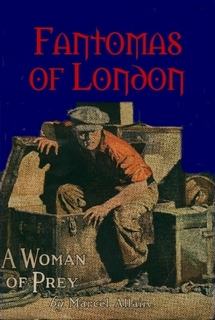 By MARCEL ALLAIN (Lulu.com; 1927/2006)
By MARCEL ALLAIN (Lulu.com; 1927/2006)
Contrary to what the title proclaims, this book is not part of the Fantomas series of novels by Marcel Allain and Pierre Souvestre. Rather, it’s a standalone 1927 novel by Allain called A WOMAN OF PREY that appeared (in four-part serialized form) in Flynn’s Detective Weekly magazine. The title FANTOMAS OF LONDON, as this book’s compiler David White admits in a brief forward, was inspired by another non-Fantomas affiliated Allain novel entitled FANTOMAS OF BERLIN—and also because “quite frankly Fantomas needs the publicity.”
David White, a Fantomas enthusiast responsible for republishing the first seven Fantomas novels through Lulu.com (White’s omnibus volume THE COLLECTED FANTOMAS is a must-own for Fantomas-philes) and authoring the excellent pastiche FANTOMAS IN AMERICA, put together FANTOMAS OF LONDON by simply photocopying the original magazine pages, resulting in text that’s not always entirely legible (and often runs off the page). White is to be commended, though, for including the vintage advertisements that appeared in Flynn’s alongside the text (including ads for “Autographic Kodaks” and Harley Davidson Twin motorcycles, promising “A thrill in every mile!”), and anyway, given that this is the only source for this wonderful tale short of tracking down the vintage magazine issues in which it initially appeared, I won’t complain too much!
The narrative is very much in keeping with the Fantomas formula, involving as it does an ingenious villain who dons a variety of improbable disguises and engages in just as many surreptitious activities. Said villain, a slime named David Dare, illegally boards a cruise ship departing from London, and surreptitiously loots its safe. The ship’s overseers are puzzled as to the hows and whys of the theft, but a passenger, the French photographer Jacques Faber, discovers in one of his pictures an element that would appear to implicate Dare in the crime. Dismayingly enough, the photo also implicates another passenger, the American millionairess Dolly Darbell, with whom Faber is besotted.
From there the narrative turns increasingly dark, with Dare making attempts on the lives of Faber and Dolly, who appears to be an accomplice to Dare’s crimes yet also his designated victim, and pulling off a most unexpected escape. As for Faber, he’s interred in a London insane asylum due to the fact that none of his claims about what happened on the ship can be verified, leading to the conclusion that he must be mad. It certainly doesn’t help his case that he can’t seem to figure out whether Dolly is good or bad, and that he begins seeing bizarre things like a shoe hanging in midair above him in his cell. There’s a happy ending, of course, and also an outrageous twist.
It’s all very old-school, from the odd (by modern standards) viewpoint shifts between Faber and his nemesis Dare—thus keeping us one step ahead of the protagonist—to the author’s liberal use of coincidence and implausibility in constructing his narrative. Yet it’s those very elements that make this tale the enjoyable page-turner it is. They truly don’t make ‘em like this anymore, and we thankfully have this volume to show us just how good the good old days truly were.
